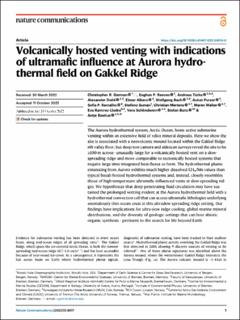Volcanically hosted venting with indications of ultramafic influence at Aurora hydrothermal field on Gakkel Ridge
German, Christopher R.; Reeves, Eoghan; Türke, Andreas; Diehl, Alexander; Albers, Elmar; Bach, Wolfgang; Purser, Autun; Ramalho, Sofia P.; Suman, Stefano; Mertens, Christian; Walter, Maren; Ramirez-Llodra, Eva; Schlindwein, Vera; Bünz, Stefan; Boetius, Antje
Journal article, Peer reviewed
Published version

Åpne
Permanent lenke
https://hdl.handle.net/11250/3030429Utgivelsesdato
2022Metadata
Vis full innførselSamlinger
- Department of Earth Science [1050]
- Registrations from Cristin [9791]
Sammendrag
The Aurora hydrothermal system, Arctic Ocean, hosts active submarine venting within an extensive field of relict mineral deposits. Here we show the site is associated with a neovolcanic mound located within the Gakkel Ridge rift-valley floor, but deep-tow camera and sidescan surveys reveal the site to be ≥100 m across—unusually large for a volcanically hosted vent on a slow-spreading ridge and more comparable to tectonically hosted systems that require large time-integrated heat-fluxes to form. The hydrothermal plume emanating from Aurora exhibits much higher dissolved CH4/Mn values than typical basalt-hosted hydrothermal systems and, instead, closely resembles those of high-temperature ultramafic-influenced vents at slow-spreading ridges. We hypothesize that deep-penetrating fluid circulation may have sustained the prolonged venting evident at the Aurora hydrothermal field with a hydrothermal convection cell that can access ultramafic lithologies underlying anomalously thin ocean crust at this ultraslow spreading ridge setting. Our findings have implications for ultra-slow ridge cooling, global marine mineral distributions, and the diversity of geologic settings that can host abiotic organic synthesis - pertinent to the search for life beyond Earth
